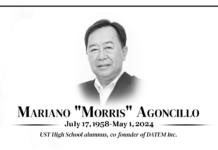“ALMOST” is Apocalypto movie hero Jaguar Paw’s alias for his slip-up moves.
“Almost a Magna Carta” is how the proposed UST charter of student rights would be called if it would let slip authentic student liberties.
In an almost confusing fashion, the Central Student Board (CSB), consisting of local student council presidents, has rushed the passage of the Magna Carta of the Students of the University of Santo Tomas that had been in gestation since 2004 (see related article, p.3).
In the run-up to the passage, many of the charter’s provisions were ordered revised by the Office for Student Affairs (OSA). On what basis the OSA could demand the revisions and the CSB to accommodate the revisions? The OSA even had itself proclaimed as the “Final Interpreter” of conflicting interpretations of the charter.
Check the first section on academic rights. What originally was a proviso barring the University from discriminating against pregnant students was ordered revised by the OSA: yes, UST would admit pregnant students, but they “must be married.” A marginal note by the OSA head said the constricting clause should be made in keeping with “the values and culture of UST.”
To be sure, the clause is hardly Thomasian; it’s more like puritanical from the days of the Scarlet Letter: for a pregnancy could have been caused by assault or date rape, in which case no one—not even the Church—could demand that the pregnant woman marry her violator.
Notwithstanding, no student should be required to marry as a precondition for education especially if he or she is not ready for marriage. Depriving a pregnant student of her basic right to education is depriving her and her unborn child a secure future. If OSA is just too eager to compromise this basic human right, what more other student rights? To be sure, barring pregnant women from enrolling in UST just because they’re not married may drive them to abortion, which hardly works to uphold the foremost Catholic value—life. (see related article, p. 8)
Moreover, the clause runs against the charter’s declaration of policies supposedly meant “to form compassionate men and women.” The pregnant student, considering her condition, all the more deserves continuous Catholic education and formation.
The closing section of the charter almost spells a final apocalypse, since it gives the OSA the power to be the “Final Interpreter” over contentious issues affecting students. A provision says a student representative is “invited” to attend, participate and vote on student-related issues, but only “whenever deemed necessary.” Of course, the necessity of the invitation is for the “Final Interpreter” to decide.
The penchant of the document to use “whenever deemed necessary” in reference to student representation seems to betray its rather grudging, if not haphazard, recognition of student rights.
Student democracy is never provisional or whimsical. It is always necessary that student representatives deliberate on any final say on student issues. The guiding principle of the charter, after all, is “dialogue,” not monologue.
Just compare the UST charter to that of La Salle, where students are made part of a trisectoral council, the student disciplinary board, the president’s council of representatives, the committees on budget, security, financial assistance and personnel services, the information systems management, etc. The students are given the right to review school policies.
Ditto with Ateneo de Manila, where there are student representatives in the school council and the committees on standards, curriculum, discipline, budget, and agenda-setting. In these schools, the relationship between the administrators, faculty and students is clearly one of trust and efficiency. The healthy relationship shows that the school exists for and because of the students.
In contrast in UST, non-academic departments seem shielded from student democracy. Students are not given the power to evaluate non-faculty services and administrators.
The UST charter should take its spirit from the proposed House Bill 17 that will nationalize a Magna Carta for students. The act, being supported by the National Youth Commission, proposes that the highest “governing board” that will hear all student issues must include students. Thus, even national education agencies will have student representatives.
In HB 17 and the charters of other universities, the student council determines the recognition of a student organization. At the least, it has a co-equal charge in accreditation. This is to prevent any student organization from owing its existence, favor and interest to the high altars of the administration.
The UST charter even empowers the OSA to be the “Final Interpreter” on the loading of subjects. The issue is clearly the dean’s jurisdiction, but the dubious proviso was incorporated into the final draft because of the demand of the OSA.
Clearly there are some provisions in the Magna Carta that may work against the student’s most basic right and interest. And these provisions should be addressed first before the document is approved. Otherwise the proposed Magna Carta may be a great work, but of dubious value.














